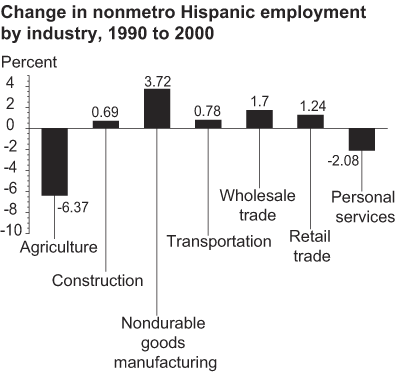Growth of Hispanics in Rural Workforce
- by Constance Newman
- 4/1/2004
Technological change and industrial restructuring in rural America in the 1990s led some employers to demand more unskilled workers relative to skilled workers (particularly males). Many of those unskilled workers were Hispanics who now represent an increased share of the rural workforce due to the rapid growth of the Hispanic population in the rural U.S. during the decade, especially in the South and Midwest.
Recent ERS research found that shifts in labor demand significantly affected wages for all rural workers regardless of gender and skill level. Two types of changes occurred in labor demand over the 1990s: 1) technological change or change in the skill mix of labor demanded (unskilled, skilled, or professional), and 2) change in the total labor demanded of each skill type. Changes in the skill mix favored unskilled workers (not high school graduates) and to a lesser extent professional workers (college-educated); but the change in the skill mix occurred in a small subset of rural industries. This change positively affected the wages of unskilled workers in those industries, broadly known to be service and manufacturing industries. On the other hand, larger changes in total labor demand strongly favored skilled workers (high school graduates) and positively affected skilled workers’ wages, especially for males.
Concurrent changes in the workforce due to the influx of Hispanics, however, negatively affected the wages of skilled men. The wages of other groups, such as females and unskilled males, were not affected by the increased labor supply of the Hispanic workforce. The results are not surprising when considering the large Hispanic population increases which occurred in specific regions. Though the rural Hispanic population was small to begin with, it tripled in more than a dozen States in the South and Midwest during the 1990s. Some rural industries, such as meatpacking, were restructured in the 1990s, and many of these industries now employ Hispanics as the majority of their workforce. During this period, the Nation’s share of Hispanics employed in agriculture fell by 6 percent while the share employed in nondurable manufacturing increased by almost 4 percent.
These results suggest that some rural service and/or manufacturing industries hired unskilled labor as substitutes for skilled labor, but that this effect is dwarfed by the larger increase in total demand for skilled labor occurring in most rural industries. The integration of this new workforce presents challenges to rural communities in terms of housing and public infrastructure, but it also presents an opportunity to revitalize communities that have been losing population.
This article is drawn from:
- Population & Migration. (n.d.). U.S. Department of Agriculture, Economic Research Service.
- Newman, C. (2003). Impacts of Hispanic Population Growth on Rural Wages. U.S. Department of Agriculture, Economic Research Service. AER-826.


